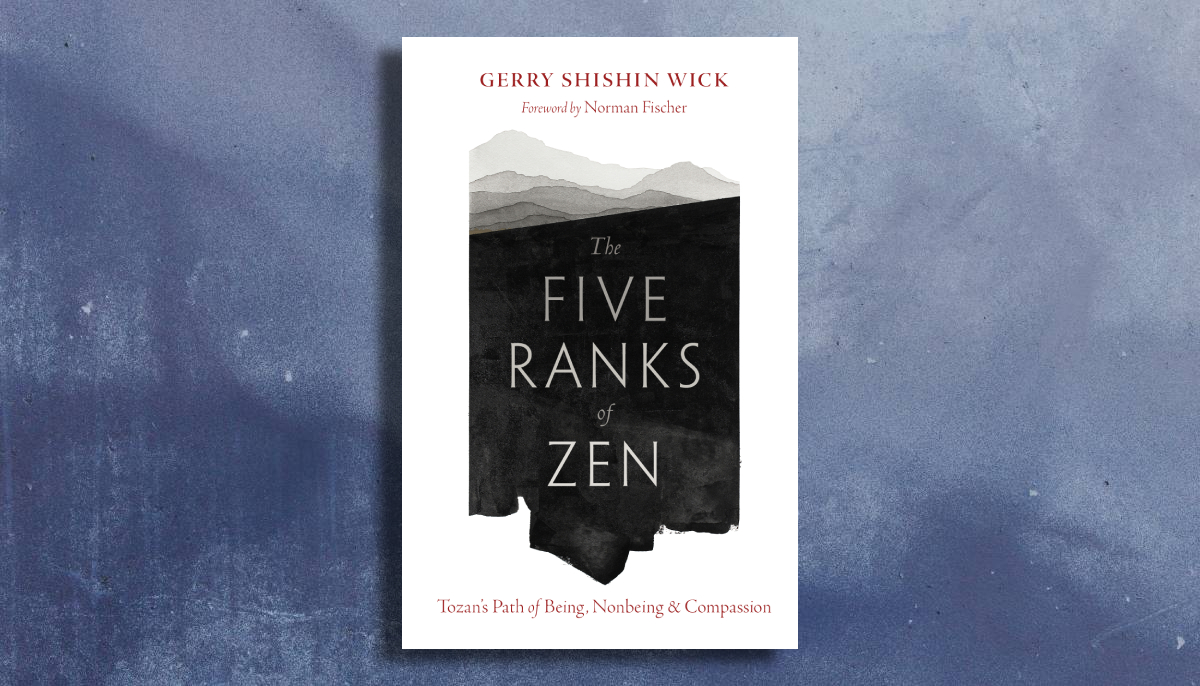Constance Kassor’s review for Buddhadharma:
Zen Buddhism is known for presenting the essence of the Buddha’s teachings in as straightforward a way as possible. While other traditions delve into complex and systematic philosophical explanations of Buddhism, Zen often cuts to the core, offering sparse yet deeply profound insights. Master Tozan, a founder of the Soto school, exemplifies this style of Zen philosophy in his teaching of the Five Ranks: a collection of short, concise explorations of the relationship between the relative and absolute realities that are integral to Mahayana Buddhism.
Gerry Shishin Wick’s The Five Ranks of Zen: Tozan’s Path of Being, Nonbeing & Compassion expertly outlines the Five Ranks, based on teachings that the author received from his own teacher, Taizan Maezumi Roshi. Tozan’s Five Ranks are an essential component in all Zen lineages; in the author’s own lineage, the Five Ranks are studied at the culmination of the koan curriculum, representing the pinnacle of a student’s training where all previous aspects of study hang together.
While the Five Ranks are ultimately meant to be realized through direct experience, this book offers readers a conceptual entry point, presenting multiple translations for each rank. This approach allows readers to appreciate the range of interpretations of these teachings, laying a foundation for personal understanding. The author then offers his own commentary on each rank, connecting them to day-to-day life and revealing their practical relevance.
[Please note that the text from which this excerpt derives makes use of footnotes and diacriticals; these are not represented in this excerpt.]
Excerpt:
Aspects of the Five Ranks
How priceless is the merit gained through the step
by-step practice of the Five Ranks of the Absolute and the Relative!
—ZEN MASTER HAKUIN (1686–1769)
The Five Ranks of Zen were first elucidated by the ninth-century Zen master Tozan (Ch. Dongshan Liangjie) and have become essential in the training of Zen students from all lineages. In my lineage, the White Plum lineage founded by the venerable Taizan Maezumi Roshi, the Five Ranks are studied at the end of our koan curriculum as the pinnacle of our training. In a way, they are also a summary of all the koan study that preceded them. My Dharma sister Roshi Egyoku Nakao told me that when her senior students start to study the Five Ranks, many of them have an “aha” moment when everything falls into place.
When I studied physics at Pomona College, we were taught different subjects—such as mechanics, optics, electricity and magnetism, thermodynamics, and atomic physics— as if they were separate and self-contained. Then, as I dug deeper into the material in graduate school at the University of California, Berkeley, it became obvious that each subject overlapped and interacted with every other subject. For example, the study of thermodynamics informed the study of mechanics. That, in turn, informed electricity and magnetism, which informed atomic physics, which also was informed by thermodynamics, and so forth. Physicists continue to seek a unifying theory that includes everything. In an analogous way, the Five Ranks are the unifying theory of Zen.
The marvelous secrets contained within the Five Ranks, however, will not be revealed through conceptual study. In order to understand the Five Ranks, you must experience them with your entire body, not just with the cells of your brain. They must penetrate your heart, bones, and marrow for the depths of their content to be revealed.
Most commentaries and books about the Five Ranks take a didactic or scholarly approach or try to explain Tozan’s teachings. In this book, I will introduce the Five Ranks in a conceptual way but emphasize their significance for our daily lives. If they do not impact our lives, they become artificial and sterile and worthless, as Zen teachings. The Five nRanks represent different ways of experiencing the relationship between and interpenetration of the absolute and relative spheres of reality. From the relative perspective, each of us manifests reality in a human form with all of our relationships, foibles, and brilliance. From the absolute perspective, each of us is whole, complete, spacious, transparent, and luminous. I suspect all of us can relate to the relative aspect of being human, yet we don’t always experience ourselves as having qualities such as completeness and luminosity. Perhaps this book will assist you in transforming your understanding of the relative and recognizing your existence within the absolute.
° ° ° ° °
What does the term “Five Ranks” actually mean? Some Zen teachers prefer to use words other than rank to describe this teaching. Robert Aitken Roshi uses modes; Roshi Egyoku Nakao uses the word positions. Their concern is that rank implies a progression, whereas the Zen view is that no step is better than the others since the entirety of the teaching is contained in each step. Zen would agree with William Blake’s exhortation “to see a world in a grain of sand and a heaven in a wildfower.”1 I’ll stick with ranks in this book, however, because most translators use that word, and it is the word used by Maezumi Roshi.
As you’ve likely noticed, the Five Ranks are in reference to something—the relative and the absolute. When I first heard the words relative and absolute, I found it difficult to connect them to my ordinary life. They seemed so abstract. It took some learning about the conceptual development and practices of Buddhism for me to begin to contextualize these terms in an experiential way.
The initial teachings of Buddhism emphasized the importance of emptiness, or the absolute basis of reality. Emptiness implies that everything is impermanent and has no fixed qualities. This includes the notion of a fixed, abiding self that most of us cling to. Our self is empty. This emptiness is the absolute because everything, without exception, is empty of a fixed nature. When I had glimpses of the absolute, it helped me understand that “my problems” were small wrinkles in space and time, and that these problems were not even “mine.” It enabled me to see the futility of clinging to my dramas and feed me to a large degree from the suffering that I carried.
The absolute is also identifed with the experience of unity or oneness. In this absolute state, there is no self and no other, thus everything is one.
Later Buddhist teachings pointed out the fallacy of emphasizing the absolute at the expense of the relative. The Perfection of Wisdom Sutra (Prajna Paramita Sutra), written about 100 B.C.e., exemplifies this approach in its denial of the duality of nirvana and samsara (the realm of our everyday lives, seen as a realm filled with much suffering). One Zen koan reduces this view to its pithiest form by saying, “Samsara is nirvana.” How do you understand that? A Zen master once said to his student, “You’re always complaining about having so many problems. I know a place where there are at least ten thousand people, and not one of them has even a single problem or worry. Would you like me to take you there?”
His student said, “Yes, please do!”
The master took him to a cemetery. As they looked out upon the collection of graves and headstones, the master exclaimed, “Die while alive, and then you can be free no matter what arises in your life!”
The student had a sudden realization and stopped complaining. He still had problems, but he looked at them in a different way. The student understood the master’s instruction to let his ego-grasping mind die. He had been shocked into awakening, and he could now see the illusory nature of his problems.
The Buddha taught that suffering is inherent in life. He also taught that there is a cause for suffering and a means to transform suffering into contentment. That transformation requires seeing the true nature of things.
The great Buddhist philosopher Nagarjuna lived in the first and second centuries in India. One of the major figures of Mahayana Buddhism, he is also considered one of the most deeply accomplished masters in our Zen lineage. Nagarjuna put Buddhist experience into a philosophical system called Madhyamaka, which espouses the Middle Way. He asserted that everything we believe exists and has permanence exists by virtue of its opposite, and thus it is subject to change and impermanence.
Let’s make this more concrete with a few simple examples. According to Nagarjuna, each side is defined by the other side. Yes makes no sense without no to compare it with. Up makes no sense without its opposite, down, and so forth.
Therefore, each side is inseparable and interdependent. It follows that nirvana and samsara constitute one inseparable reality. Nagarjuna concluded that all dharmas (phenomena) are empty of any inherent or distinctive attributes. He called them emptiness, or sunyata in Sanskrit.
Emptiness is a condition of no fixed entity, or of no selfness. Since each thing exists only by virtue of its opposite, he demonstrates that all things are only relative to other things and are without essence. That is, they are empty.
However, although everything is empty, we still exist and function in the phenomenal world. What, then, is the relationship between the two realms of the absolute and the relative? That is the subject of the Five Ranks and the topic of this book.
° ° ° ° °
When we study the Five Ranks of Tozan in the White Plum lineage, we study them in two different sets. The first is called Hensho Goi, where hen means “relative,” sho means “absolute,” and goi means “Five Ranks.” It is what most people think when they first encounter the Five Ranks of Tozan. Here is my version of the Hensho Goi:
Rank 1: The relative in the midst of the absolute
Rank 2: The absolute in the midst of the relative
Rank 3: Coming in the midst of the absolute
Rank 4: Reaching in the midst of the relative
Rank 5: Arriving in the midst of absolute/relative (unity realized)
From The Five Ranks of Zen: Tozan’s Path of Being, Nonbeing, and Compassion by Gerry Shishin Wick © 2024 by Gerald L. Wick. Reprinted in arrangement with Shambhala Publications, Inc. Boulder, CO.



